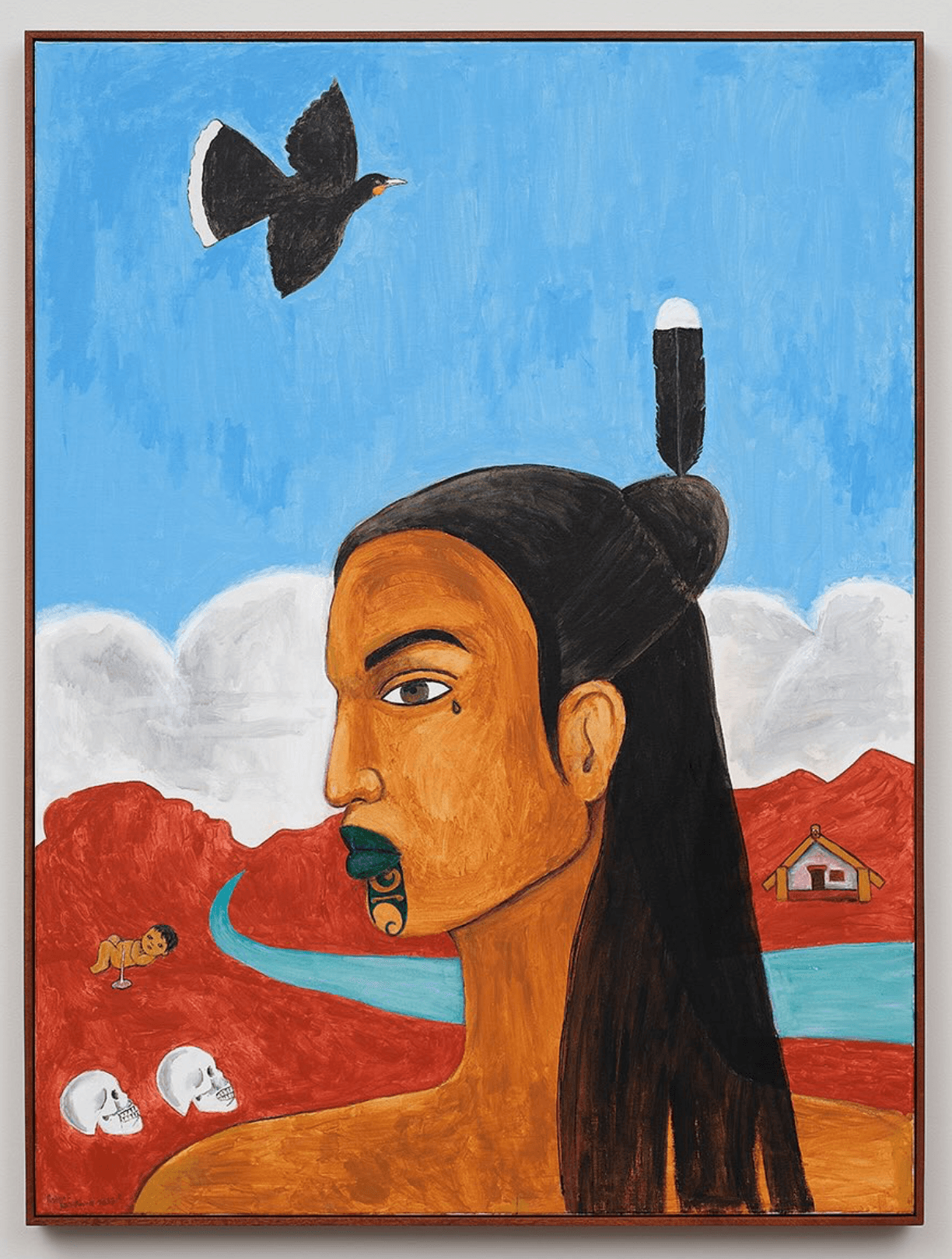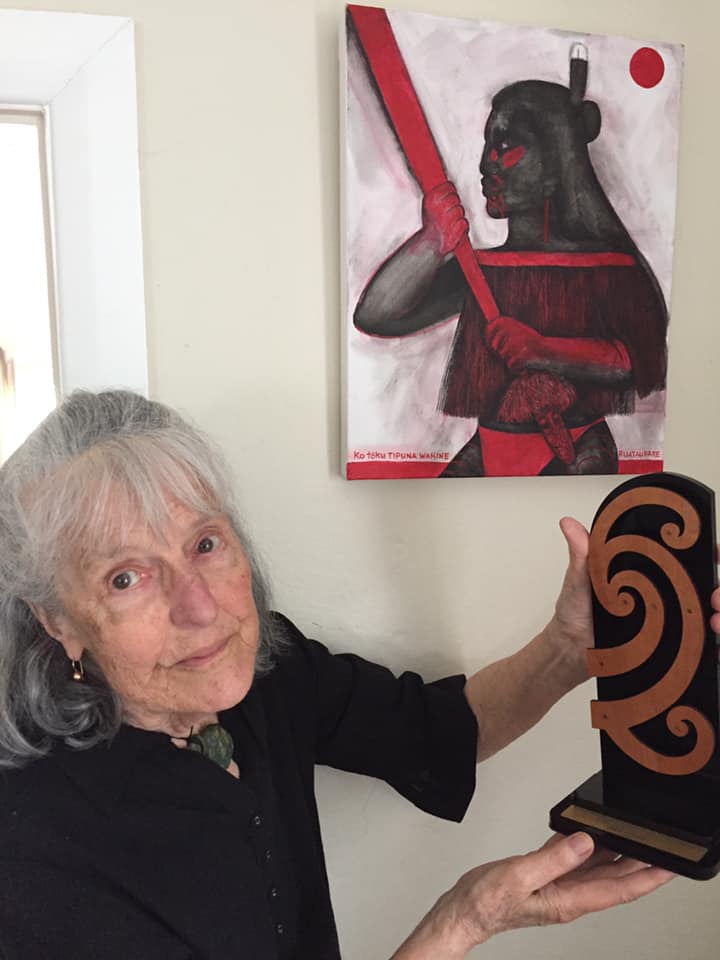"Absolutely Iconic" Robyn Kahukiwa Remembered as Trailblazer
Whānau, artists and gallerists pay tribute to a wāhine toa, whose talents and staunch belief in Māori rights have left a huge impression on the next generation.

The passing of one of the leading lights in ngā toi Māori has left the creative community in mourning.
Much admired Māori artist and writer Robyn Kahukiwa (Ngāti Porou, Te Aitanga-a-Hauiti, Ngāti Konohi, and Te Whānau-a-Ruataupare) died on Friday 11 April, at Wellington Hospital at the age of 86.
She's been described as "one of the leading artists of her generation and one the first Māori women artists to achieve international renown" by her gallerist, Francis McWhannell of Season Aotearoa.
"She worked tirelessly to uplift Māori people, values, and rights. Her art traverses a wide range of media and styles, exploring questions of heritage, identity, and sovereignty central to the Māori experience and relevant to Indigenous people from around the world."
Daughter Reina Kahukiwa has released a statement on behalf of her whānau, underlining her mother's staunch belief in Tino Rangatiratanga.

"My mother and our Nanny Robyn was a courageous Wahine Toa throughout her life and in her passing. She was a private person in her personal life. She always said ‘My art speaks for me.’
"Based on her political beliefs, Robyn turned down state and crown honours awards, however in 2020, Kahukiwa received the Te Tohu Aroha mō Te Arikinui Dame Te Atairangikaahu | Exemplary/Supreme Award at the Te Waka Toi Awards, in recognition of her life’s work.
"Mum and Nanny, you leave a huge hole in our lives. We love and will miss you so very much. You leave your great legacy of Māori art, and the taonga of your stories and illustrations for us your whānau, your mokopuna, and future generations."
The news of Kahukiwa's passing led to a flood of tributes across social media - underlining her impact and the inspiration she proved to many.
Nigel Borell - who included Kahukiwa's mahi in the ground-breaking Toi Tū Toi Ora: Māori Contemporary Art exhibition at Auckland Art Gallery - simply referred to here as "absolutely iconic."
Artist Peata Larkin declared that Kahukiwa was "A force to be reckoned with. You burst through the glass ceiling and paved the way for many wāhine toi to follow in your footsteps. You are embedded in Te Ao Māori."
Award-winning sculptor Ngaroma Riley posted "Robyn Kahukiwa gifted te iwi Māori so many powerful and impactful images. Her work has been hugely influential for many of us. Her loss is felt but her legacy lives on."

Illustrator Isobel Te-Aho White - who illustrated Kahukiwa for the book Kia Kaha: A Storybook of Māori who Changed the World - desbribed her as "a fearless trailblazer in her advocacy for mana wahine and māori sovereignty, and her artistic legacy is seen in the work of the many wāhine ringatoi who have been influenced and guided by her."
One of those inspired by Kahukiwa is acclaimed Māori artist Nikau Hindin. In an earlier tribute on Instagram, Hindin wrote "Robyn Kahukiwa’s paintings have captured the imagination of a generation and her paintings like our carvings are the USBs for our pūrakau. Her Toi Māori has informed who we are and how we see ourselves but she has also furthered the whakapapa of Toi Māori through her reinvigoration of our pūrakau about our Atua wahine.
"I’ve always looked up to Kahukiwa and aspired to be an artist like her. She paved the way for us and I wouldn’t be here without her."
Artist and curator Vasemaca Tavola of Vunilagi Vou shared "Deepest gratitude and respect for generously gifting us decades and volumes of visual poetry. What a privilege it has been to know this work. Rest in love and power."
From her first solo exhibition in 1971 at Wellington's Red Cottage Gallery, Kahukiwa began leaving what would become an indelible impression on Aotearoa. While working as an arts teacher at Porirua's Mana College, her work in the 70s saw her make "broadly realist work exploring diverse subjects, including motherhood, environmental issues, and the experiences of Māori living in urban contexts," according to her agent.
It wasn't until 1983 that she realised her ambition of becoming a full-time artist theough the support of a grant, which saw Kahukiwa complete her ground-breaking Wāhine Toa exhibition, which emphasised the importance of atua wāhine, and toured the country from 1983 to 1984.

During the 1980s, she began illustrating and writing books, in addition to making art. Taniwha, the first of many children’s books authored by Kahukiwa, was named the Children’s Picture Book of the Year in 1987. In 1983, aided by a grant, she became a full-time artist and In the second half of the decade, her paint-handling became expressionistic and she increasingly made use of vibrant colour.
A key member of Haeata Māori Women’s Art Collective, Kahukiwa began earning recognition for not just her paintings but her writing and illustrations too - writing a number of successful, award-winning books.
Her art has become a stable of most major public art institutions and many private collections. Kahukiwa's international reputation is also immense, after having participated in group exhibitions and workshops in Australia, Great Britain, the United States and as part of 2023's Sharjah Biennial.
Season Aotearoa state "Kahukiwa emphasised political subjects throughout her career, addressing the negative impacts of colonisation on Māori and promoting mana motuhake and mana wāhine. Her activism found expression not only through her art but also through groups like Kia Mau, which she co-founded with Tina Ngata, the late Moana Jackson, and others. Many of her later works focus on social issues, such as child poverty, incarceration, and homelessness. Grounded in whakapapa and tikanga, her work always sought to foster Māori wellbeing.
"The passing of Robyn Kahukiwa represents an immense loss, but her legacy will only grow with the passage of time. Many of her books remain in print, including the seminal Wāhine Toa: Omniscient Māori Women (1984/2018), Taniwha (1986), Paikea (1994), and Te Haka a Tānerore (2018, winner in the New Zealand Book Awards for Children and Young Adults) and Taranga (2023), both written by Reina Kahukiwa. A significant survey exhibition, Tohunga Mahi Toi, curated by Roma Pōtiki, is presently touring Aotearoa. A major publication, a retrospective exhibition, and a solo exhibition to be presented in London are in development."
At Kahukiwa’s request, her life will be honoured through a small, private gathering of her whānau and will eventually be taken back to Ngāti Whakaue to be with her husband, Dooley Kahukiwa, at Kauae.